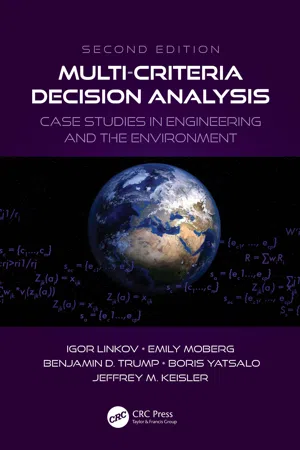
Multi-Criteria Decision Analysis
Case Studies in Engineering and the Environment
Igor Linkov, Emily Moberg, Benjamin D. Trump, Boris Yatsalo, Jeffrey M. Keisler
- 392 páginas
- English
- ePUB (apto para móviles)
- Disponible en iOS y Android
Multi-Criteria Decision Analysis
Case Studies in Engineering and the Environment
Igor Linkov, Emily Moberg, Benjamin D. Trump, Boris Yatsalo, Jeffrey M. Keisler
Información del libro
Decision analysis has become widely recognized as an important process for translating science into management actions. With climate change and other systemic threats as driving forces in creating environmental and engineering problems, there is a great need for understanding decision making frameworks through a case-study based approach. Management of environmental and engineering projects is often complicated and multidisciplinary in scope and nature, thus issues that arise can be difficult to solve analytically. Multi-Criteria Decision Analysis: Case Studies in Engineering and the Environment provides detailed description of MCDA methods and tools and illustrates their applications through case studies focused on sustainability and system engineering applications.
New in the Second Edition:
-
- Addresses current and emerging environmental and engineering problems
-
- Includes seven new case studies to illustrate different management situations applicable at the international level
-
- Builds on real case studies from recent and relevant environmental and engineering management experience
-
- Describes advanced MCDA techniques and extensions used by practitioners
-
- Provides corresponding decision models implemented using the DECERNS software package
-
- Gives a more holistic approach to teaching MCDA methodology with a focus on sustainable solutions and adoption of new technologies, including nanotechnology and synthetic biology
Given the novelty and inherent applicability of this decision-making framework to the environmental and engineering fields, a greater number of teaching tools for this topic need to be made available. This book provides those teaching tools, covering the breadth of the applications of MCDA methodologies with clear explanations of the MCDA process. The case studies are implemented in the DECERNS software package, allowing readers to experiment and explore and to understand the full process by which environmental managers assess these problems.
This book is a great resource for professionals and students seeking to learn decision analysis techniques and apply similar frameworks to environmental and engineering projects
Preguntas frecuentes
Información
Part I
Multi-Criteria Decision Analysis: Methods and Applications
1
Background
MCDA Methods
- Problem Identification: The problem is defined in terms of relevant stakeholders and overall structure but is not yet described quantitatively.
- Problem Structuring: The problem is fleshed out by defining alternatives and criteria. Alternatives—the potential management options—are defined. The alternatives are what a decision maker is deciding among. Criteria—the set of properties (such as cost or environmental impact) that describe alternative performance—are also established. The criteria are essentially what the decision maker values; performance against these criteria is what is used to decide among alternatives.
- Model Assessment/Building: The alternatives and criteria are given numeric values. The alternatives are scored against the criteria (e.g. Plan A may cost $2,000, so its score for cost may be “$2,000” or “high” depending on our setup). Decision makers (or stakeholders) also weight criteria according to the value or importance they put on that criterion. This gives us the information how well does each alternative perform on each criterion and how much do we care about performance on each criterion.
- Model Application: The inputs—the criteria weights and alternative scoring—are combined in an MCDA model and output which alternative is best according to the data given. Each model works in a slightly different way (as will be explained later in this chapter) but essentially combines the preference and scoring information for each alternative. The output can range from an ordered list of alternatives to a set of probabilities that an alternative will be well accepted or not.
- Planning and Extension: Once the model has been run, the output can be used to make decisions or inform further planning.
MAUT
Índice
- Cover
- Half Title
- Series Page
- Title Page
- Copyright Page
- Dedication
- Table of Contents
- Foreword
- Preface
- Acknowledgments
- Authors
- Part I Multi-Criteria Decision Analysis: Methods and Applications
- Part II MCDA Methods in Depth: Sediment Management
- Part III MCDA Application in Depth: Nanomaterials
- Part IV MCDA Application Case Studies
- Appendix
- Index